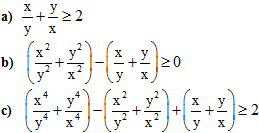
Hãy nhập câu hỏi của bạn vào đây, nếu là tài khoản VIP, bạn sẽ được ưu tiên trả lời.


a) Vì \(\left|A+B\right|\ge0\)và \(\left|A\right|+\left|B\right|\ge0\)
Bình phương 2 vế ta có:
\(\left|A+B\right|^2\le\left(\left|A\right|+\left|B\right|\right)^2\)
\(\Leftrightarrow A^2+2AB+B^2\le A^2+2\left|AB\right|+B^2\)
\(\Leftrightarrow2\left|AB\right|\ge2AB\)\(\Leftrightarrow\left|AB\right|\ge AB\)(1)
Theo tính chất của dấu giá trị tuyệt đối thì \(\left|AB\right|\ge AB\)
\(\Rightarrow\)(1) luôn đúng \(\Rightarrow\left|A+B\right|\le\left|A\right|+\left|B\right|\)( đpcm )
Dấu " = " xảy ra \(\Leftrightarrow AB\ge0\)
b) \(M=\sqrt{x^2+4x+4}+\sqrt{x^2-6x+9}=\sqrt{\left(x+2\right)^2}+\sqrt{\left(x-3\right)^2}\)
\(=\left|x+2\right|+\left|x-3\right|=\left|x+2\right|+\left|3-x\right|\)
Áp dụng kết quả phần a ta có:
\(M=\left|x+2\right|+\left|3-x\right|\ge\left|x+2+3-x\right|=\left|5\right|=5\)
Dấu " = " xảy ra \(\Leftrightarrow\left(x+2\right)\left(3-x\right)\ge0\)
TH1: \(\hept{\begin{cases}x+2\ge0\\3-x\ge0\end{cases}}\Leftrightarrow\hept{\begin{cases}x\ge-2\\x\le3\end{cases}}\Leftrightarrow-2\le x\le3\)
TH2: \(\hept{\begin{cases}x+2< 0\\3-x< 0\end{cases}}\Leftrightarrow\hept{\begin{cases}x< -2\\x>3\end{cases}}\)( vô lý )
Vậy \(minM=5\)\(\Leftrightarrow-2\le x\le3\)
a) Do 2 vế của BĐT không âm nên ta có:
\(\left|A+B\right|\le\left|A\right|+\left|B\right|\Leftrightarrow\left|A+B\right|^2\le\left(\left|A\right|+\left|B\right|\right)^2\)
\(\Leftrightarrow A^2+B^2+2AB\le A^2+B^2+2\left|AB\right|\Leftrightarrow AB\le\left|AB\right|\) (LUÔN ĐÚNG)
Dấu '=' xảy ra <=> \(AB\ge0\)


Câu 31:
Ta có: \(4=2x+xy\ge2\sqrt{2x.xy}=2\sqrt{2}\sqrt{A}\)
suy ra \(A\le\frac{4^2}{2^2.2}=2\).
Dấu \(=\)khi \(\hept{\begin{cases}2x=xy\\2x+xy=4\end{cases}}\Leftrightarrow\hept{\begin{cases}x=1\\y=2\end{cases}}\).
Câu 10:
ĐK: \(x\inℝ\).
Ta có:
\(VT=\sqrt{3x^2+6x+7}+\sqrt{5x^2+10x+21}\)
\(=\sqrt{3x^2+6x+3+4}+\sqrt{5x^2+10x+5+16}\)
\(=\sqrt{3\left(x+1\right)^2+4}+\sqrt{5\left(x+1\right)^2+16}\)
\(\ge\sqrt{4}+\sqrt{16}=2+4=6\).
Dấu \(=\)khi \(x+1=0\Leftrightarrow x=-1\).
\(VP=5-2x-x^2=6-\left(x^2+2x+1\right)=6-\left(x+1\right)^2\le6\)
Dấu \(=\)khi \(x+1=0\Leftrightarrow x=-1\).
Do đó nghiệm của phương trình đã cho là \(x=-1\).

a) \(\frac{a+b}{2}\ge\sqrt{ab}\)
\(a+b\ge-2\sqrt{ab}\)
\(\left(a=\sqrt{a}\times\sqrt{a}=\sqrt{a}^2;b=\sqrt{b}\times\sqrt{b}=\sqrt{b^2}\right)\)
\(\sqrt{a}^2-2\sqrt{ab}+\sqrt{b}^2\ge0\)
\(\left(\sqrt{a}-\sqrt{b}\right)^2\ge0\left(đpcm\right)\)
( vi bất kì số nào bình phương cũng là số dương mà ^^~ )


câu 43:
ĐKXĐ: \(x\ge5\) hoặc \(x\le-1\)
\(2x^2-8x-3\sqrt{x^2-4x-5}=12\)
\(\Leftrightarrow2\left(x^2-4x-5\right)-3\sqrt{x^2-4x-5}-2=0\)
Đặt \(t=\sqrt{x^2-4x-5}\left(t\ge0\right)\)
pt trở thành:
\(2t^2-3t-2=0\)
\(\Leftrightarrow\left[{}\begin{matrix}t=2\left(tm\right)\\t=-\dfrac{1}{2}\left(ktm\right)\end{matrix}\right.\)
\(\Rightarrow\sqrt{x^2-4x-5}=2\)
\(\Leftrightarrow x^2-4x-9=0\)
\(\Leftrightarrow\left[{}\begin{matrix}x=2+\sqrt{13}\\x=2-\sqrt{13}\end{matrix}\right.\)
KL: Pt có tập nghiệm \(S=\left\{2+\sqrt{13};2-\sqrt{13}\right\}\)
A: Ta có: \(x^2+x+2=\left(x+\dfrac{1}{2}\right)^2+\dfrac{7}{4}>0,\forall x\in R\)
\(\Rightarrow A=\sqrt{x^2+x+2}\) luôn có nghĩa với mọi x
B: Biểu thức có nghĩa \(\Leftrightarrow1-3x>0\Leftrightarrow x< \dfrac{1}{3}\)
C: Biểu thức có nghĩa \(\Leftrightarrow1-9x^2\ge0\Leftrightarrow-\dfrac{1}{3}\le x\le\dfrac{1}{3}\)
D: Biểu thức có nghĩa \(\Leftrightarrow x^2-5x+6>0\)
\(\Leftrightarrow\left(x-3\right)\left(x-2\right)>0\)
\(\Leftrightarrow\left[{}\begin{matrix}x>3\\x< 2\end{matrix}\right.\)





